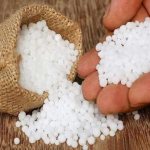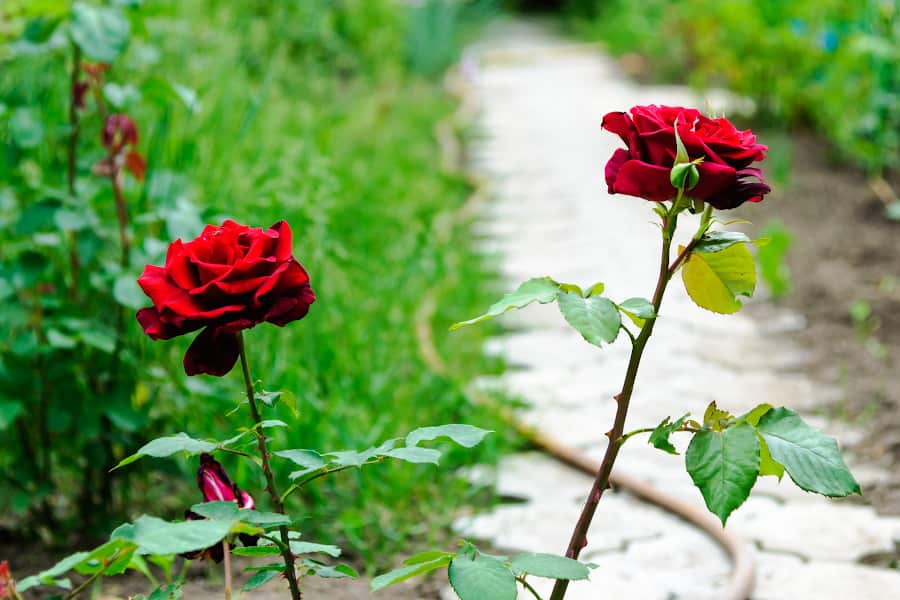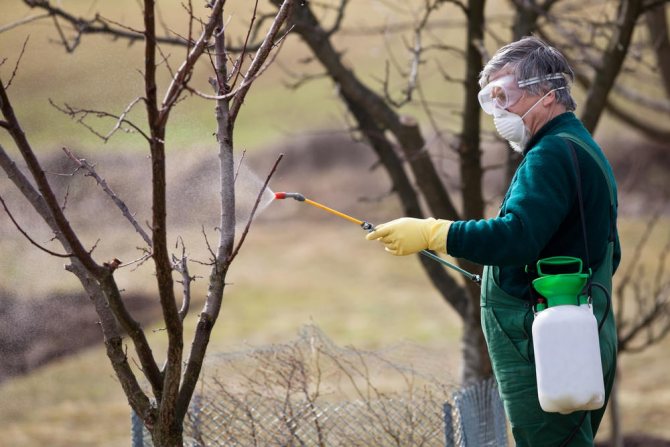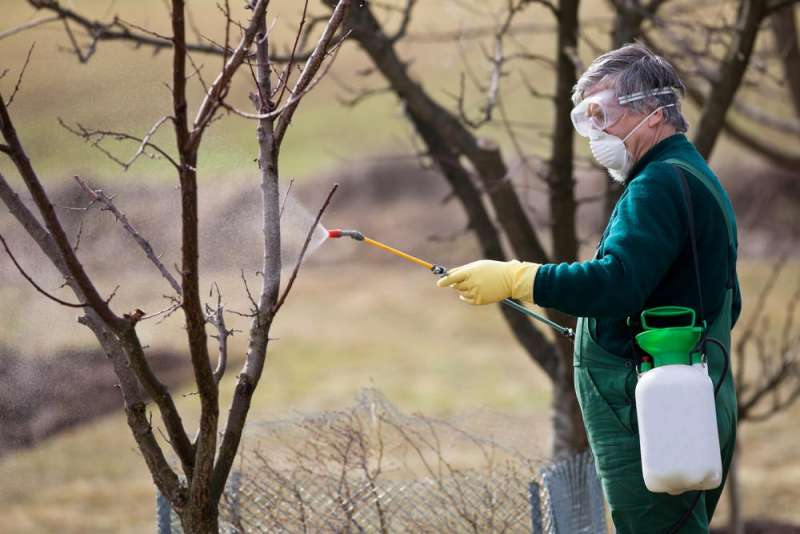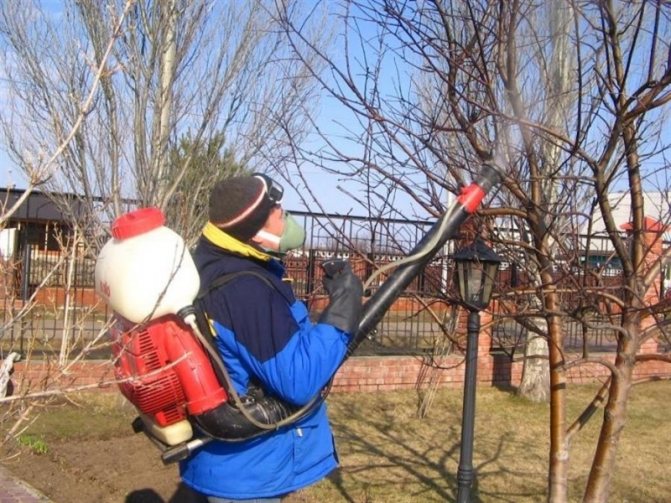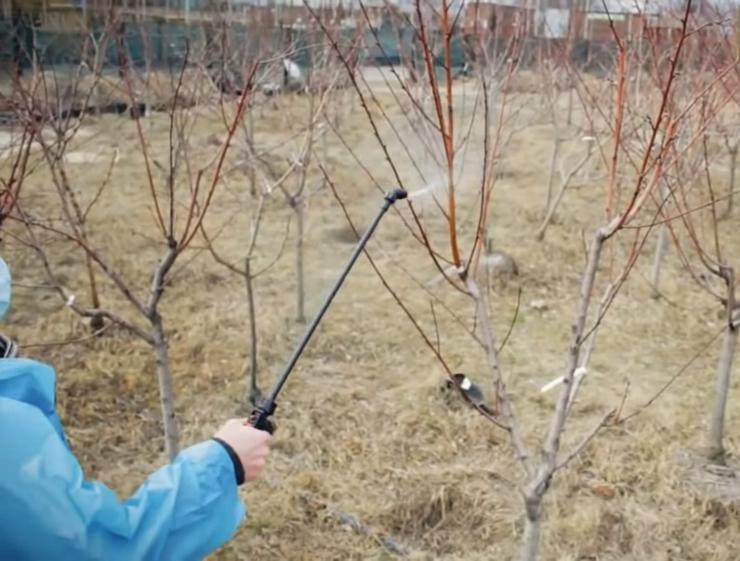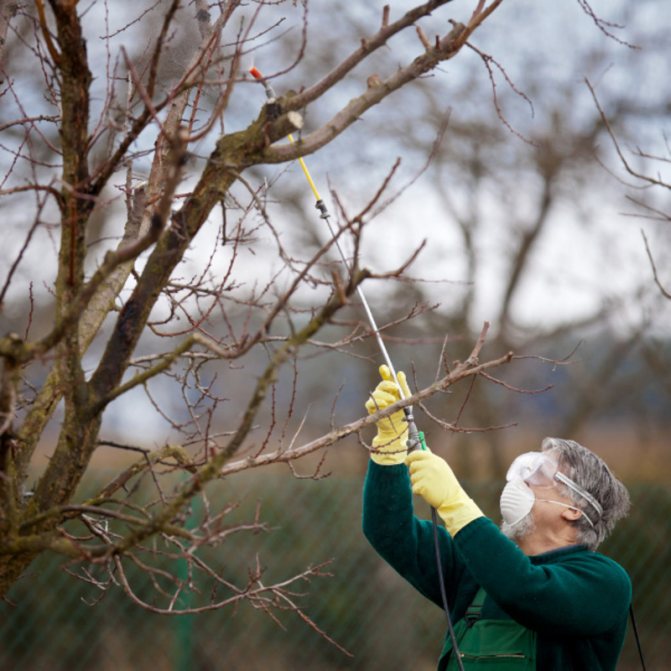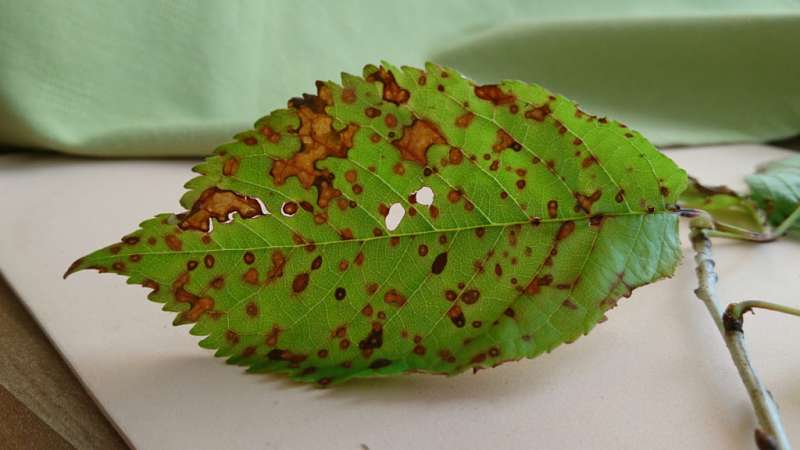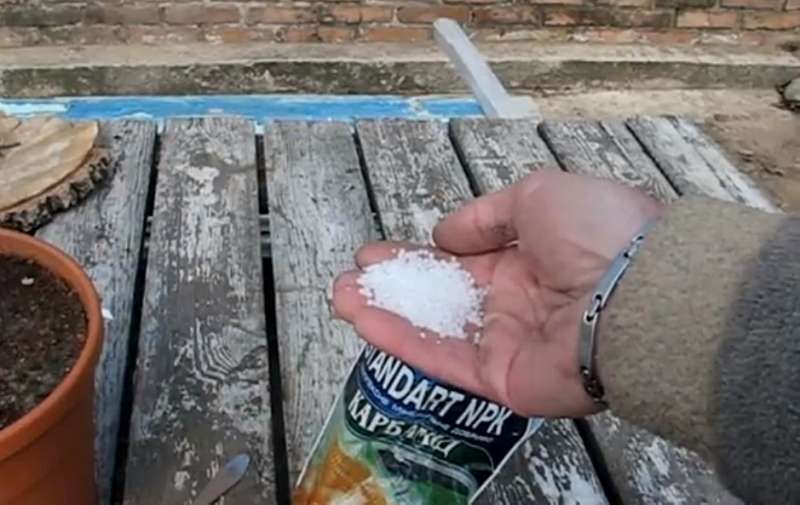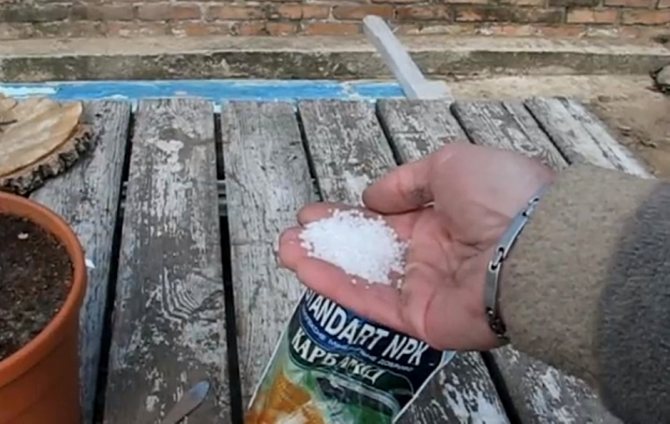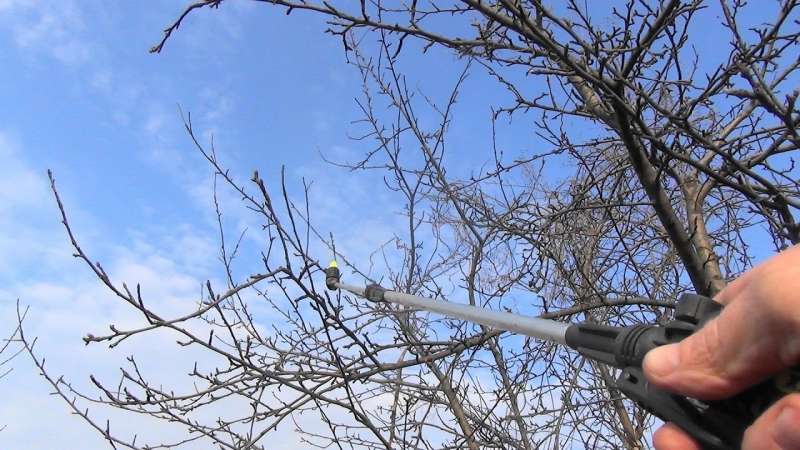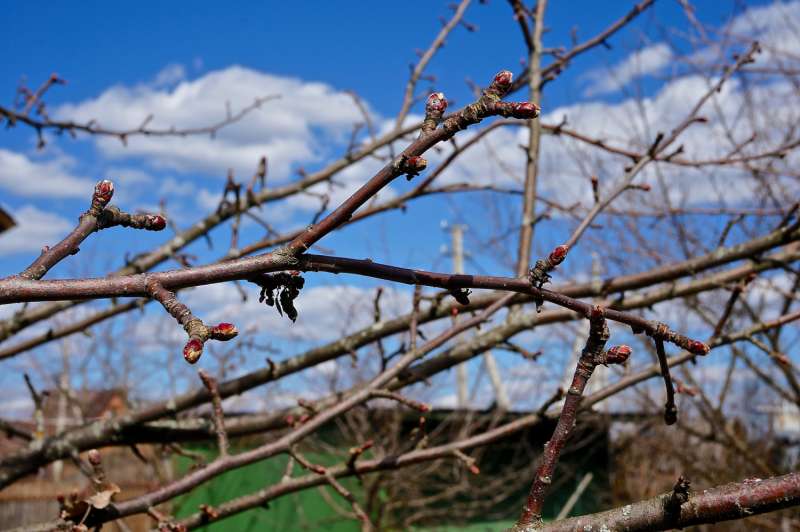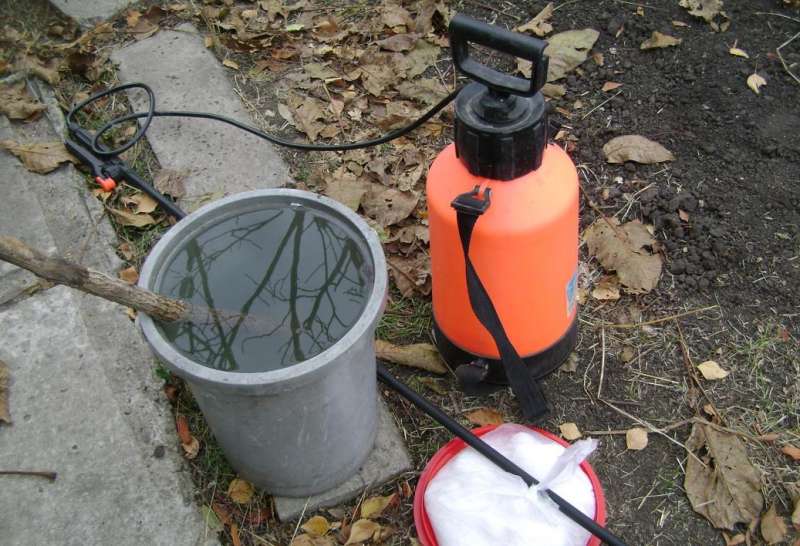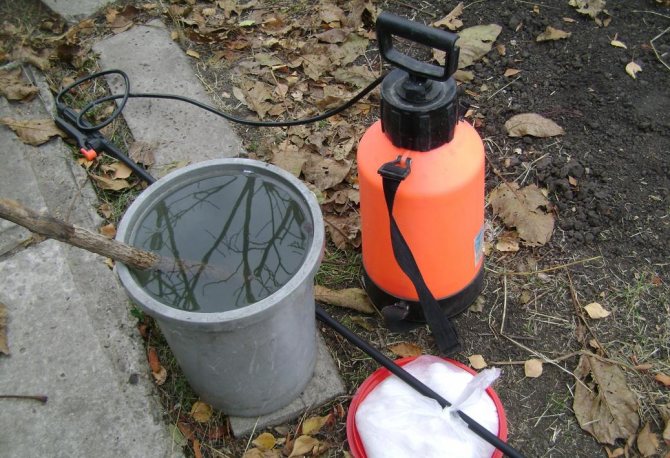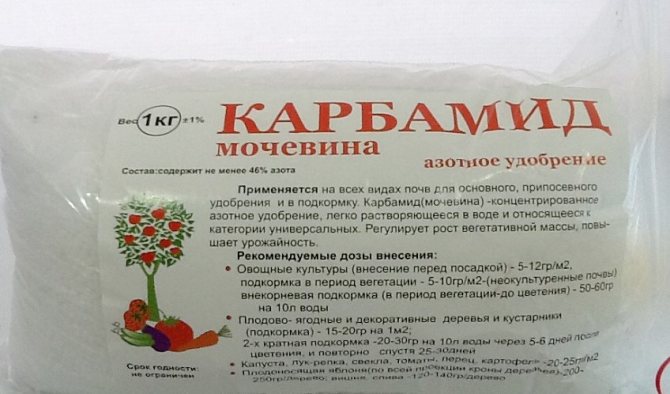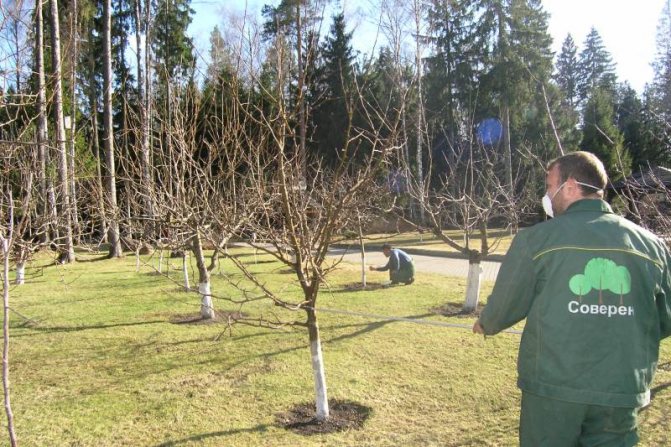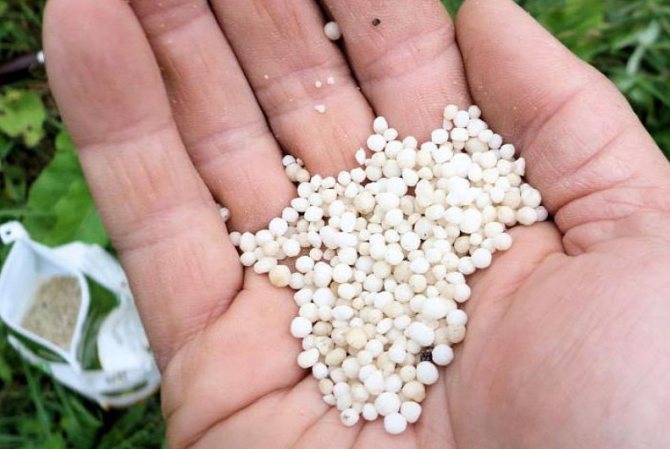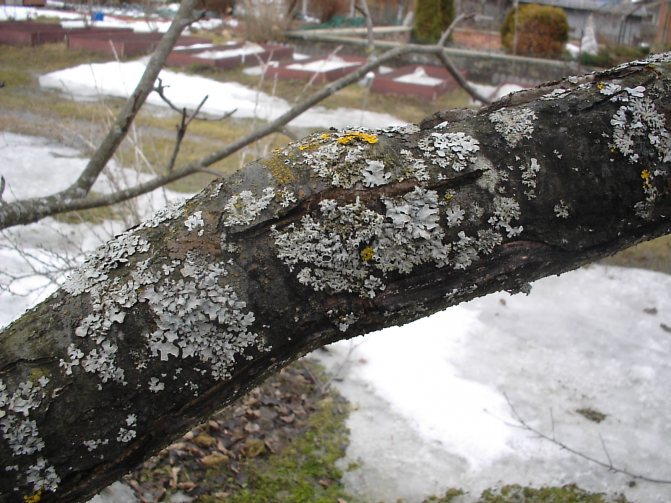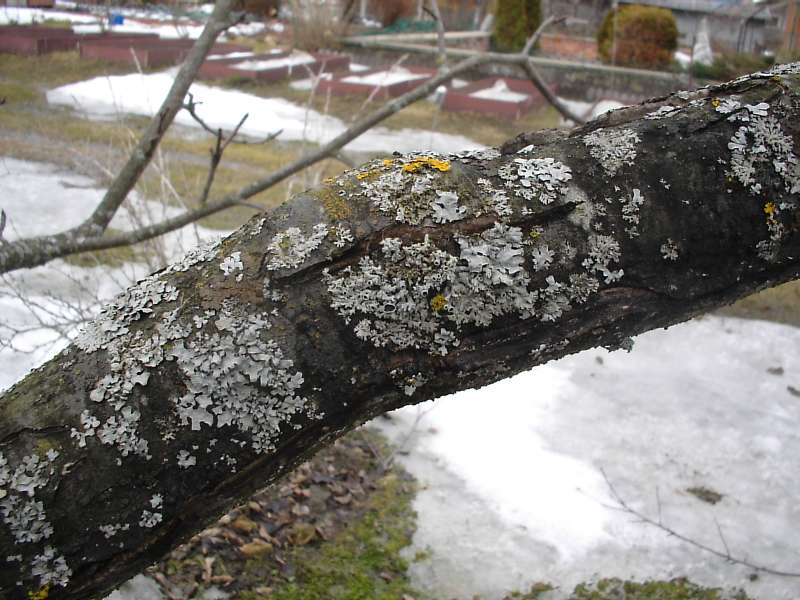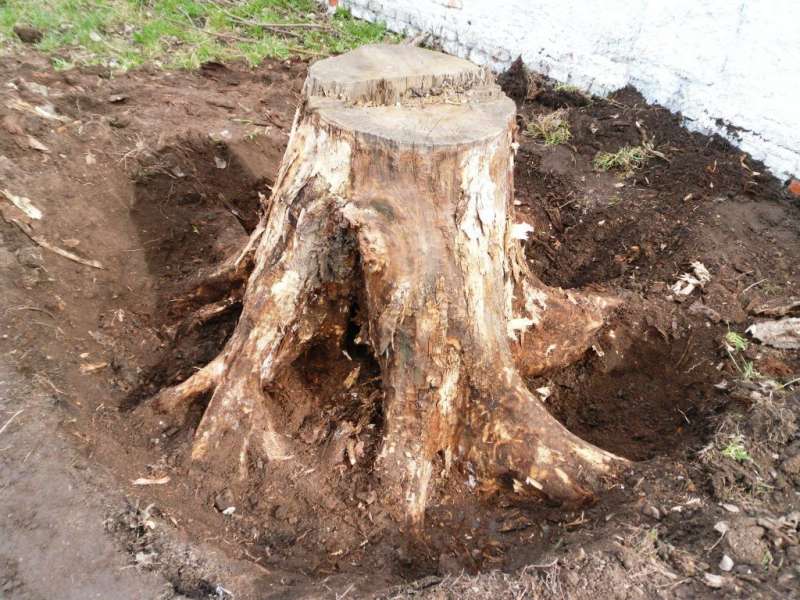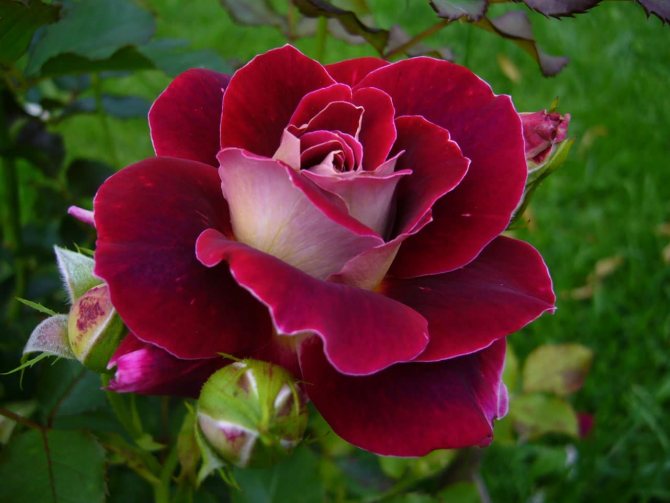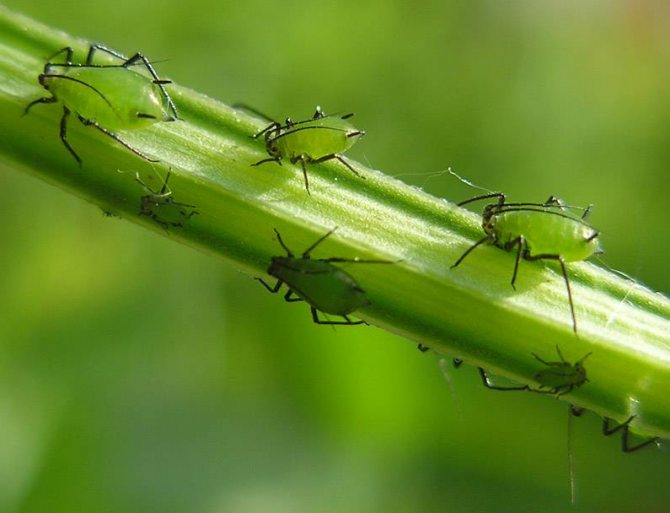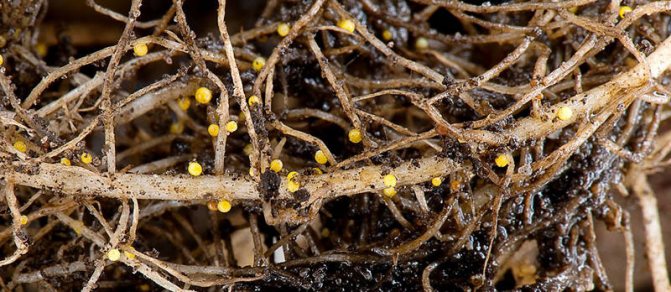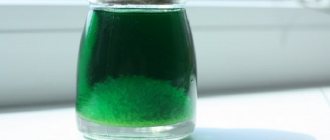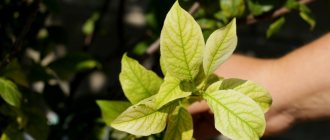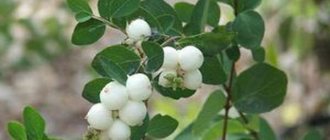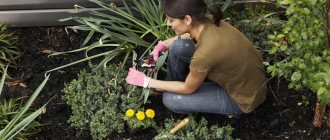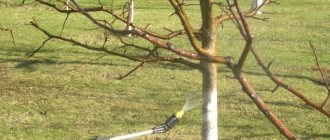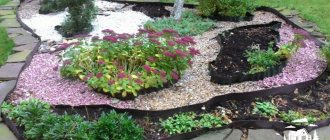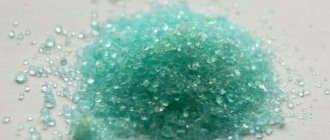How to process fruit trees in autumn
Together with the trees, numerous garden pests are preparing for winter. Some of them hibernate in fallen leaves, others choose lesions and folds of bark as a shelter. Many bury themselves in the soil, hibernating directly in the trunk circles.
Spraying with fungicides also plays an important role in disease prevention. Pathogens, fungal spores are constantly on the bark of the tree, and autumn processing very effectively prevents their development.
The main task of processing fruit trees in the autumn is to prepare them for winter. In addition, the following tasks are being solved:
- Destruction of pests hibernating on the trunk and branches.
- Destruction of insects and their larvae wintering in the soil of the trunk circle.
- Fight against manifestations of rot, fungal infections.
- Cleaning the tree from moss, lichens, plaque.
Summarizing the above, we can conclude: it is necessary to process fruit trees in the fall. You can use a variety of formulations as spraying agents, buying ready-made mixtures and preparations in stores or making them yourself.
To process the garden in the fall, you can use any of the drugs below.
| Name of the drug | Appointment | Processing time |
| Bordeaux mixture 1% or 3% | Complex preparation for putrefactive, fungal and other diseases | After the leaves fall, before the onset of frost |
| inkstone | Destruction of mosses, lichens | -//- |
| Copper sulfate | Prevention of scab, coccomycosis, rot, spotting, clotterosporosis | -//- |
| Urea | Destruction of larvae of insect pests | -//- |
| Preparations Skor Karbofos (Skor Bison) | An aqueous solution of a mixture of drugs is effective both against insect larvae and against diseases | -//- |
The most popular remedy for treating fruit trees in the fall from pests is urea. It is effective against leafworm larvae, weevils, and also against scab pathogens. The crown is treated with an aqueous solution of 4-5% concentration; for the treatment of near-trunk circles, the urea content must be increased to 8%.
| Name | Concentration | Appointment |
| Copper sulfate 1 or 3% | 100 or 300 g of substance per 10 l of water | For the prevention and destruction of spots, monoliosis, coccomycosis, etc. |
| Iron vitriol 2 or 4% | 200 or 400 g of substance per 10 l of water | Destruction of mosses, lichens, prevention of powdery mildew, monoliosis, rot. |
| Bordeaux mixture 3% | 300 g of copper sulphate 400 g of quicklime per 10 liters of water | Against scab, gray rot, coccomycosis, etc. |
An important condition for starting work on spraying garden plantings in the fall is the absence of foliage. Falling leaves serves as a kind of signal that the tree has entered hibernation mode. Processing should be done before the onset of frost, on a dry, calm day.
This will promote better absorption of the fungicides into the bark. Before spraying, you need to clean the bark of the trees and prune them, if such is provided for in the plan. Trunk circles must be completely cleaned of fallen leaves.
The processing of each tree must be started from the highest point of the crown, sequentially walking around it in a circle and spraying all the tiers of the plant from top to bottom. It is convenient to use a long boom sprayer for this.
Dwarf, columnar and saplings can be sprayed with a small hand sprayer or spray bottle. After finishing work with the crown, the trunks are treated, increasing the concentration of the active substance. For this procedure, you can use a regular watering can.
Among gardeners, the most popular treatment of plants after harvest is 1% Bordeaux liquid. This tool helps to destroy dangerous fungi - pathogens of scab, powdery mildew, rot and other diseases.
After leaf fall, but no later than the end of October, the crown of bushes and trees and the soil under them are sprayed with a solution of urea (carbamide). This is an excellent prevention of scab and spotting.
We invite you to familiarize yourself with Trees processing in autumn Spraying trees in autumn
It is a highly efficient granulation fertilizer containing in an assimilable form the nutrient nitrogen necessary for plant growth and development. Its mass fraction in fertilizer is 46%. Urea is the most popular spraying agent.
How to transplant a violet correctly?
How to plant tulips in the fall?
How to prune lilacs correctly?
At the same time, it burns out many fungal diseases, even some of the pests that try to winter on fruit trees. Treating a garden in autumn with urea is a chemical treatment, not a fertilization of trees.
It is carried out over the entire crown of a tree or berry bush and the adjacent ground around the tree is necessarily sprayed. Almost all pome and stone fruit crops, as well as berry bushes, are sprayed with urea.
Treatment of the garden with urea in the fall, spraying trees, application in the garden
Full care of garden plants is not only about grafting and pruning branches, applying fertilizers and timely harvesting. Regular spraying of shrubs and trees with special preparations is of great importance. Often, urea is used for these purposes, which protects the garden from pests, and is also a useful organic additive.
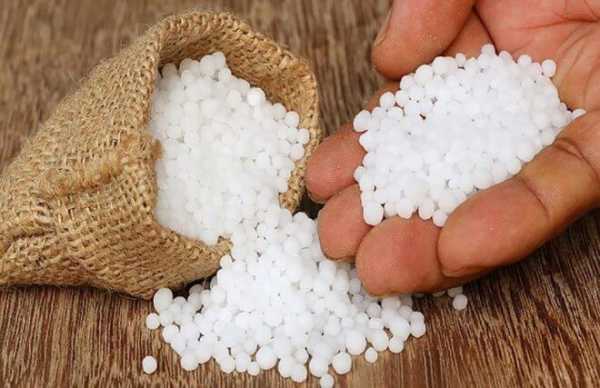
Urea use in the fall
Urea or urea is a synthesis product of ammonia and carbon dioxide. It is produced in the form of small granular white solid crystals. The nitrogen contained in this fertilizer is essential for the normal development and growth of plants. Deficiency of this chemical element leads to a deterioration in the appearance of trees and a decrease in yield.
Autumn weather is characterized by an increase in humidity and a decrease in temperature. It is these climatic conditions that are favorable for the development of infections and various diseases of fruit trees. By using urea treatment, such negative effects can be avoided.
Apple trees, cherries, pears, apricots and sweet cherries need to be sprayed not only in case of obvious parasite infestation, but also for prophylaxis. Such procedures provide trees with strength, health, intense flowering and a high probability of fruit set.
Treatment of plants prevents the development of the following diseases:
- scab;
- putrefactive processes;
- spotting;
- reproduction of parasites;
- fungal infections.
Urea effectively fights the listed pathologies, improves the condition of plants, and increases yields.
Terms of introduction
Late autumn is considered the ideal time for processing. It is recommended to start it when there are practically no leaves on the trees. Otherwise, the concentrated composition can cause burns and premature foliage.As a result, the tree becomes vulnerable to the effects of frost.
Experienced gardeners treat the garden with carbamide in late October - early November. All leaves from trees and shrubs are carefully collected and burned. This helps to eliminate all pests that are preparing for wintering. After that, dead bark fragments and lichens are removed. Coating the trunks with a layer of whitewash disinfects surfaces and protects even from extreme cold.
Processing is carried out only in dry weather with no wind at all. If it rains on the day the procedure was performed, all the manipulations will have to be repeated.
Preparation of the preparation
To work, you need urea, water, a ladder and a garden sprayer. 10 liters of water will require at least 500 g of urea. The mixture is thoroughly mixed, and then filtered through cheesecloth several times.
A mixture of carbamide with copper sulfate will become especially effective in the fight against insects parasitizing in the bark. For cooking, you will need 700 g of urea and 50 g of copper sulfate, which are diluted in a bucket of water (10 l). Such a composition performs 2 functions at once: the destruction of pests by them, replenishment of the soil.
Attention should be paid to garden trees, especially if they already have bark diseases. The affected fragments are carefully removed so that the urea can penetrate more actively to the areas where the parasites live. Foliage does not break off, even if there are pathogenic signs on it. After wintering, leaves sprayed with a carbamide solution will become a safe compost for plants.
Before processing, several important recommendations must be taken into account:
- do not spray the garden if the air temperature drops below + 5 ° C;
- dead areas of the bark are removed with a special metal brush, dried and rotten branches are cut off;
- the cracks in the trunk are examined, and the insects found are destroyed.
The soil under trees and shrubs must be dug up and loosened. Not only plants are subject to processing, but also fallen leaves.
Spraying trees
Spraying should cover the trunks and crown of plants as much as possible. If they already have manifestations of diseases, special attention is paid to the affected areas. Some gardeners rake and burn foliage. But you can not remove it, but carefully treat it with urea. The drug destroys pests and infectious agents, promotes the rapid decomposition of leaves. As a result, they turn into an excellent natural fertilizer for the garden.
When performing the procedure, it is important to adhere to several rules:
- Spraying is carried out only after performing preliminary preparation: digging up the soil, removing affected branches, whitewashing.
- A dry sunny day with a complete absence of wind is suitable for processing. If the weather is hot, you should start work early in the morning or after sunset.
- The preparation and application of the solution is carried out only in protective gloves, glasses and clothing.
- The most effective spraying is done using a special sprayer. This device allows you to handle even the tallest plants.
- When working, you cannot spare the composition, since it will not bring any harm to trees and shrubs.
- If precipitation falls immediately after treatment, the procedure is repeated. Otherwise, the desired result will not be achieved.
Branches, trunks and soil are treated with urea. It is important to adhere to the recommended dosage. A high concentration of the solution burns the plants, provokes early fall of foliage. As a result, trees will receive less nutrients and will be more susceptible to low temperatures.
Soil application
Urea is also suitable for the care of various ornamental and fruit trees, shrubs. This versatile product is applied to the soil to feed and protect plants from parasites.Currently, urea is considered one of the most popular fertilizers. Urea is safe and highly effective, which explains the high demand from consumers. The cost of feeding is an order of magnitude higher compared to nitrogen-containing analogues. The fact is that urea is not a natural compound. It is extracted by synthesis from carbon dioxide and ammonia. Experts are sure that the price fully justifies the quality of the fertilizer.
Nitrogen starvation in plants is manifested by several pronounced signs:
- slow growth of seedlings;
- curling and yellowness of the leaves;
- weak flowering, lack of ovaries;
- low yield, early shedding of fruits.
Fertilization is done in the morning or evening, always on a dry day. If it is raining outside, it is worth postponing the work for another time. A solution is often used, for preparation it is necessary to dilute 30 - 40 g of carbamide in 10 liters of water.
Dosages for soil application:
- For potatoes, various varieties of onions, tomatoes, cabbage, sweet peppers, no more than 20 - 25 g of carbamide per 1 m² is required.
- For feeding cucumbers and legumes - 5 - 8 g per m².
- Gooseberry bushes are fertilized with urea diluted in water in proportions of 10 g per bucket of water (10 l).
- For strawberries, blackberries, garden strawberries, it is necessary to dissolve about 35 g of urea in 10 liters of water. Each plant should have at least 1 liter of ready-made solution.
- Zucchini, squash, eggplant need 10 - 12 g per 1 m².
- Currants will bear more fruit if watered with a carbamide solution (20 g per bucket of water).
If necessary, fruit trees are fertilized during the fruiting period. Apple trees are watered with a composition of 230 - 250 g per bucket of water. Plums and cherries are fed with a less concentrated solution: 120 - 150 g of carbamide per bucket of water. It is not necessary to dilute the fertilizer with water. You can add dry crystals, but then you need to make abundant watering.
If garden plants are fertilized with organic substances, the rates of urea application are reduced by 1/3 or 2 times. It all depends on the amount of organic matter.
Safety engineering
Work is carried out using a special spray gun that carefully sprays the necessary substances. To protect your health from the negative effects of pesticides, you should follow these precautions:
- it is possible to prepare and spray the solution only in protective gloves, goggles and a respirator;
- all work is carried out only on a calm dry day;
- after completing the procedures, you must thoroughly wash your hands and face, wash all work clothes immediately.
Safety instructions are mandatory.
Conclusion
Processing the garden with urea is not difficult, but effective. Correct implementation of the procedure will protect trees from many diseases and pests. Due to the nitrogen content, carbamide activates growth, productivity and plant resistance to negative factors.
Urea as a substance and its action
Urea or Urea is a concentrated nitrogen fertilizer (46%) in the form of odorless white crystals, which is used both for spraying trees and for watering, feeding, planting plants, including garden plants.
Its active ingredient is nitrogen, which not only promotes the growth and development of plants, but also destroys their pests, prevents fruit decay.
Urea or Urea is a concentrated nitrogen fertilizer (46%) in the form of odorless white crystals, which is used both for spraying trees and for watering, feeding, planting plants, including garden plants.
When is the treatment carried out?
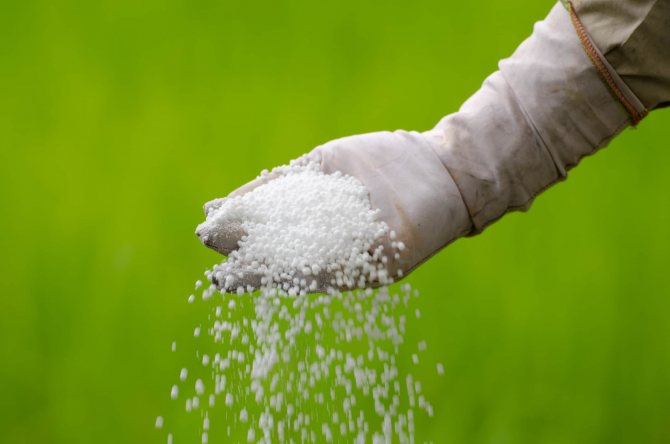

Spraying trees and shrubs with urea is performed in autumn and spring.
Spring processing
In spring, urea can be added immediately after thawing, and a little later - during and after flowering.It all depends on the thickening of the foliage - the richer it is, the sooner all procedures must be completed. With young foliage, for example, on plums and pears, processing can be carried out quite late in spring and even in summer.
The use of such a remedy in early spring makes it possible to achieve high efficiency of prevention against various pests and to protect young shoots from freezing.
Autumn processing
During autumn processing, it is important that the solution falls on the entire crown as a whole, as well as on the soil in the near-trunk circle. In this case, it will be possible to maintain the immunity of plants and exclude their death in winter, as well as neutralize all foci of possible infections.
On plants with obvious signs of infection with various diseases, it is recommended to additionally process the trunks, as well as fallen leaves, with a high concentration solution. The optimal time is November, after the second stage of leaf fall. Previously, this should not be done, since the opposite effect may occur - leaf burns, a decrease in frost resistance.
Preparing for autumn garden work
The optimal time for processing the garden is the second half of October, and if the autumn is long and warm enough, then the beginning of November, even if frosts have already happened by this time. The foliage, as a rule, is already flying around, so nothing will prevent you from spraying efficiently. It is best to choose a clear day without precipitation for this procedure.
Before spraying trees, you need to carry out sanitary pruning and completely clean the tree trunks from fallen leaves. It is also necessary to stock up on a sufficient amount of solution for work, rinse and test the sprayer, and also stock up on personal protective equipment.
For small trees, you can use a hand sprayer or spray bottle. For large ones, it is better to use a knapsack sprayer, and process the upper tier of the crown from a stepladder.
When to spray a garden in the fall?
Autumn treatments are carried out after complete leaf fall, when the tree has passed into a state of dormancy, the buds have closed
- at the end of autumn (in October-November, depending on the region),
- when the plants stop growing,
- at temperatures not lower than 0 ° C and not higher than +5 ° C.
IMPORTANT
Autumn processing should not be carried out at negative air temperatures!
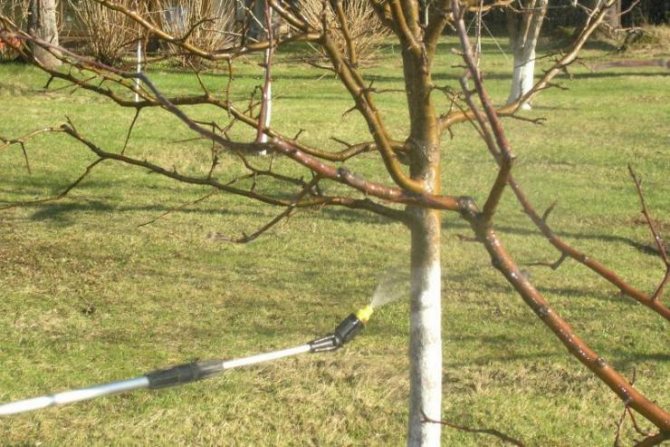

Preparation of urea solution
The principle of preparing the solution is very simple: since urea dissolves well in water, pour the required amount of granules with 2 liters of water and stir until the carbamide is completely dissolved, then add water to the volume required according to the instructions.
The urea solution is used to feed almost all garden and horticultural crops. Urea is produced in two types:
- under the “A” mark, raw materials are sold for the production of feed additives for animal food, as well as for the manufacture of glue and resin;
- under the “B” label, urea is sold for use as fertilizer.
However, despite the versatility and effectiveness of urea, which is used both as the main fertilizer and as a top dressing, it is very important to observe the correct proportions of urea for each plant when preparing the solution.
We offer you to familiarize yourself with How to quickly clean an apartment and keep order constantly?
For example, foliar top dressing with urea of ornamental trees and shrubs requires a solution of 18-32 g of urea in 10 liters. water, and spring and summer foliar feeding with urea of vegetable crops is carried out with a solution of 51-62 g of fertilizer in 10 liters. water at a flow rate of 3 liters. solution for 100 m² of plantings.
How to register
The use of all the advantages of a personal account is available to the current clients of the provider after the conclusion of the contract. To register, you need to go to the official website through a PC, tablet or phone by doing the following:
one.In the upper right corner, select "Personal Account".


2. For authorized users, log in by login or contract number and password, and for those who logged in for the first time or forgot their password, click on the link “Log in for the first time or forgot your password?”.


3. Choose authorization by Email or phone number.
It is important to indicate exactly the data that was specified in the contract, otherwise the system will not be able to find the information and the entrance to Akado's personal account will be unavailable.


4. We confirm access to the mailbox through the link in the letter, and the phone number - with a special code.
Preparations for spraying fruit trees
There are quite a few different drugs that are used to treat fruit trees from pests and diseases. These include the following:
- urea (urea) solution;
- Bordeaux liquid;
- copper sulfate solution;
- ferrous sulfate solution;
- mineral fertilizer solution;
- other fungicides and insecticides.
Urea (urea) is a fairly common water-soluble ammonia fertilizer. To prepare a spray solution, you need to dilute 0.4-0.5 kg of the substance in a bucket of water (10 l). Spraying with urea is effective against scab pathogens.
A solution of increased concentration (7-8%) is also treated with trunks, destroying pests hibernating there. However, care must be taken that such a solution does not fall on the bark of the tree, otherwise the plant will receive a chemical burn.
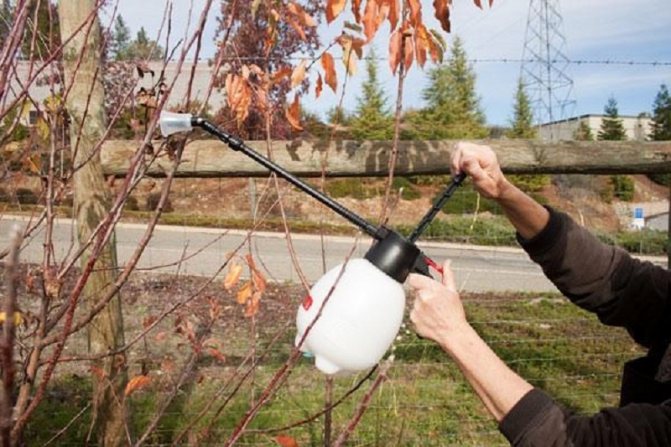

Iron vitriol is widely used in horticulture as a means of combating and preventing diseases such as scab, powdery mildew, fruit rot (monoliosis), black cancer and others. It is also a very effective remedy against various mosses and lichens that parasitize on the bark of fruit trees.
Iron vitriol is a water-soluble compound. To prepare the solution, you need to take 200-300 g of funds for 1 bucket of water, if the trees were sick with any disease during the season, the proportion of vitriol can be increased to 400 g.
Preparations containing copper have long been successfully used for plant protection by gardeners around the world. One of these agents is copper sulfate, a well-known substance used both as a micronutrient fertilizer and as a broad-spectrum fungicide (antifungal agent).
To prepare a spray solution, mix 100 g of copper sulfate and 10 liters of water. If diseases were noted on the plants during the season, then vitriol should be taken 300 g. The substance dissolves well in water, giving it a characteristic blue color.
In addition to urea, copper and iron sulfate in pure form, their combinations with each other are also used. For example, the use of ferrous sulfate in a mixture with urea (200 g of each preparation per 1 bucket of water) gives a good result.
There are other preparations that can be used in the fall for spraying fruit trees for diseases. These include the well-known Bordeaux mixture, which is copper sulfate in combination with quicklime.
- copper sulfate - 300 g;
- quicklime - 400 g.
Each of the components is dissolved in 5 liters of water. Then the solution of copper sulfate is carefully added to the lime solution, taking precautions and stirring constantly.
If during the year fruit and berry trees did not hurt, the concentration of the solution can be reduced to 1%. This will require the content of all ingredients to be reduced by 3 times. The very procedure for preparing Bordeaux liquid remains unchanged.
For the autumn treatment of the garden from pests, you can also use insecticides, for example, Fufanon or Preparation 30 Plus. These are quite effective remedies, however, only the autumn treatment will not give the desired result.
Main rules
When spraying crops in spring, you need to follow some rules. The main features include the following:
- Fruit crops should be sprayed with a 1% solution until the buds swell.This will protect trees from parasites, in particular from copperheads and aphids, and also increase resistance to diseases, especially fruit rot and black crayfish.
- To obtain early shoots, it is recommended to soak the seeds in a 0.2% mixture of vitriol and urea solutions. It is necessary to withstand the seeds for 24 hours, with the exception of cucumbers (8-10 hours are enough for them).
- For disinfection of the roots of planted plants, it is recommended to use a 1% solution of urea and vitriol. The roots of the seedlings must be lowered into the composition for 3 minutes. After that, the roots must be rinsed with plenty of water.
- Before planting potatoes, it is recommended to treat the tubers with a 0.2% copper-carbamide solution to protect the garden crop from late blight.
- When the average daily temperature in spring is +5 degrees or a little more, the soil should be watered with a 5% copper-carbamide solution. The same remedy can be used to treat diseases of garden crops, in particular, tomatoes, cabbage and any root vegetables.
- It is advisable to pickle the seed in case of suspicious diseases or due to poor heredity. For pumpkin and tomato seeds, you need to prepare a solution, taking into account the fact that for one standard bucket of water you need to add boric acid in an amount of 2 g, potassium permanganate - 10 g, copper sulfate - 1 g. In this composition, the seeds are soaked for a quarter of an hour, and then this is washed 2-3 times with water. It is allowed to use the solution for seeds of other garden plants.
The weather plays a huge role during the processing of crops. Keep in mind that the remedy begins to act instantly and retains its result for one to two weeks at a night temperature of +15 degrees and a daytime temperature of +25 degrees. The effect disappears after rain, but it is impossible to re-spray the plants, as this will lead to an overabundance of copper in the soil, which will negatively affect the crops.


How to process fruit trees in autumn
Determining the time for processing fruit trees is very simple. As soon as ants appear in the grass under the trees, an invasion of aphids and other pests can be expected in the very near future. In a very short time, these parasites can leave your garden without a crop.
We invite you to familiarize yourself with Hot fog treatment for cockroaches
It's time to start work:
- You can start treating the garden with urea if you have properly prepared the trees for this - you dug up the ground under them, removed frozen and damaged branches, whitewashed the tree trunks.
- For work, a sunny and, which is especially important, a calm day is suitable. If the weather is hot, it is advisable to spray in the early morning or evening after sunset.
- It is necessary to prepare the solution and carry out the spraying itself in protective clothing, a mask, glasses and gloves.
- For spraying, it is best to use a special sprayer. Even very tall trees can be processed with it.
- When processing trees, do not spare the solution, it is impossible to harm them.
- If precipitation falls after spraying, it will be necessary to repeat the procedure, otherwise everything will be in vain.
- It is possible not to prepare the solution, but add dry urea, but in this case it is necessary to thoroughly water the trees with water.
- In the case of feeding trees with organic matter, the application rates of urea must be reduced by 1/3 or half, it depends on the amount of organic feeding.
Urea: correct use, dosage, timing
- Subscribe to
- Publication feed
- Latest publications
- Best publications of all time
- For half a year
- per month
- Diseases and pests
6 ares
Subscribe Login / REGISTER
6cotok.org
Autumn spraying of the garden with nitrogen-containing fertilizer
The onset of cold weather, high humidity, which accompanies late autumn, are the optimal environment for the formation of infections and diseases of the fruit trees in your garden. To prevent this, it is necessary to carry out the autumn treatment of the garden with urea in the form of spraying.
Cherry, sweet cherry, apricot and especially apple, pear and plum need to be treated not only for obvious pests, but also for prevention. This will provide your trees not only with health, but also strength for lush flowering and a large ovary of fruits in spring.
Dear visitors, please save this article on social networks. We publish very useful articles to help you in your business. Share! Click!
- Fungal infections;
- Scab;
- Spotting;
- Putrid diseases;
- Pests living and hibernating in the bark of a tree, etc.
- Dissolve 300 gr. copper (for apple trees - iron) vitriol in 3 liters of water;
- 400 gr. mix fluff lime with 10 liters of water;
- Pour the diluted vitriol into the lime mortar, stirring constantly;
- Strain the resulting composition through cheesecloth folded several times.
The best time is late autumn. Urea, as a highly concentrated nitrogen-containing fertilizer, should be used in late autumn for the prevention and destruction of pests, i.e. when the leaf fall is at the second stage or has already ended.
In autumn, the fruitful is sprayed twice. For the first time at the beginning of autumn with urea - this is the last replenishment of vegetation with nitrogen. It is not recommended to use nitrogen-containing formulations anymore.
After leaf fall, the plants are treated with preparations aimed at combating putrefactive diseases. You can buy specialty chemicals to spray your garden in the fall, or make a great mixture at home:
By the way, the above solution has a light blue color, so don't be surprised. Yes, your plants will be slightly painted in a heavenly color, but they will remain absolutely healthy, and the “paint” will wash off over time.
from preparation to spraying, instruction
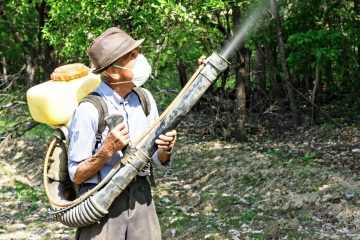

The increased humidity, which is observed with the onset of cold weather, is the optimal condition for the emergence and spread of infectious diseases of garden trees.
To prevent an undesirable phenomenon, it is necessary to treat the garden with urea in the fall. We also have instructions for spring processing - see here.
The procedure will protect trees in the winter cold and guarantees a thriving bloom in spring.
What is Urea?
Urea (urea) - a chemical compound, presented in the form of a scattering of solid granular crystals of white color and odorless.
It is a product of the synthesis of carbon dioxide and ammonia according to the Bazarov formula. In manufacturing plants, it is manufactured in parallel with other ammonia-based substances.
Use as fertilizer
The nitrogen contained in urea is essential plants for full development. With a lack of a chemical element, garden trees bear fruit worse, lose their presentable appearance.
In addition, urea protects against infectious and putrefactive diseases, spotting, and insect pests.
How to prepare urea for spraying
Required components:
- urea;
- water;
- sprayer;
- stairs.
For processing the garden in autumn urea (500-700 g) is diluted in 10 liters of water, after which the solution is filtered several times through cheesecloth. At the same time, not only trees and shrubs are treated, but also fallen leaves.
Features of spraying the garden in autumn
The best time is late autumn... It is advisable to start processing when the period of leaf fall is nearing completion.
Otherwise, a highly concentrated nitrogen solution can lead to premature fall of foliage and the formation of burns, respectively, making trees more vulnerable to frost.
Spraying is carried out in calm weather.Treating the garden in autumn with urea will give a greater effect if it is carried out on a calm sunny day.
The absence of wind will also protect the worker and nearby people, animals from unwanted portions of pesticides contained in the fertilizer.
Preliminary work
Before spraying it is necessary to pay attention to trees that have bark diseases.
To do this, remove the affected areas, freeing urea direct access to problem areas and areas of accumulation of winter pests.
The leaves are left even in the presence of various kinds of diseases on them and are also sprayed. After winter, foliage treated with ammonia solution, will perfectly act as a compost for trees.
How to handle
Shallow spraying gives maximum effect... The crown, trunk, and also fallen leaves lend themselves to processing with urea.
Safety engineering
You should always remember about your health and beforehand when processing the garden in autumn with urea. take care of appropriate equipment: gauze bandage or respirator mask, goggles for eye protection, rubber gloves.
Urea is a universal fertilizer for various types of vegetation.
In the case of an autumn garden treatment, a carbamide solution will prevent the formation of infectious diseases, protect trees from pests, and contribute to abundant flowering and a rich harvest.
Caring for the garden after processing
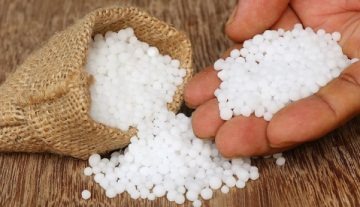

After spraying, it is advisable not to disturb the garden plantings for several days, so that the active substance has time to be absorbed into the bark. Then you can continue pre-winter preparation. The stems and lower skeletal branches must be whitewashed with lime mortar, if this has not been done previously. This will protect them from frost damage and sunburn.
To protect against rodents, protective grilles are installed, a net is pulled or the trunks are wrapped with spruce branches.
Processing of currants with urea. Chemicals
Both gentle agents (quasi-natural chemicals) and chemicals are used.
The first group includes:
- Bordeaux mixture is a universal remedy against fungi. The protective effect is about 30 days, in addition, the currants are provided with nutrition (due to calcium and copper). Apply 1% solution (before the buds swell), 3% - "rosebud phase";
- copper sulfate is a means of contact action, a 1% solution is used, finely dispersed spraying is mandatory;
- iron vitriol - prepared immediately before use with a 2.5% solution;
- urea - take 500-700 g per standard bucket of water, spray the culture in early spring, only at positive temperatures (+ 5ºC and above);
- ammonia is a simple but effective means of getting rid of aphids. Proportions: 50 ml of ammonia is taken in a 10-liter bucket.
On a note! In all treatments, regardless of the type of preparation, alternation of funds is recommended.
Among the fungicidal agents based on the chemical basis of spring treatments, the following are suitable (the active ingredient is indicated in parentheses):
- from the spheroteka - Hom, Abiga-Peak, Oxyhom (oxadixyl, copper oxychloride), colloidal sulfur, Topaz, Bayleton (triadimefon), Fundazol, Tiovit Jet;
- from various types of spots - Skor, Raek;
- from all types of rust, septoria, anthracnose - Tilt, Forecast.
The terms of use, dosage, purpose are indicated on the packaging of each drug. Information is required for study, it is prohibited to exceed the dosage.
Treating pests with solutions of insecticidal agents of intestinal action:
- Actellik;
- Kinmix;
- Fufanon, Aliot (malathion);
- Prophylactin (a combination of vaseline oil and malathion);
- Inta-Vir;
- Gerold (based on diflubenzuron);
- Inta Ts-M;
- Karate Zeon.
From the means of systemic action:
- Biotlin;
- Tanrek;
- Confidor;
- Spark Double effect (based on cypermethrin and permethrin);
- Aktara.
To prevent the appearance of moths, scale insects, treatments are shown with a solution of a contact action drug - 30 Plus.
"Chemistry" is effective both for prophylaxis and for surgical treatment.
inkstone
It is also a good helper in the treatment and prevention of diseases in horticultural crops. It enriches plants with iron in an easily assimilated form, it is vital on calcareous and saline soils. With iron starvation (chlorosis), the tops of the shoots are lightened to yellow, deformed and crumbled.
For spring processing, 1-3% (100-300 g) solutions are prepared for 10 liters of water, for feeding 5-10 g of powder for the same 10 liters. Iron vitriol is suitable for all plants, relieves them of moss, lichen, fungus, chlorosis, pests and their larvae.
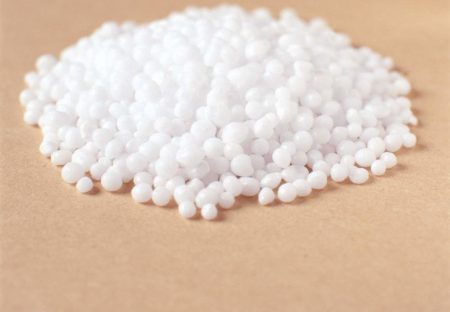

When caring for fruit trees and shrubs, do not forget about a sense of proportion:
- do not fill the plants with a large amount of solution,
- consume liquid at the rate of 2 liters for a young plant, 10 liters for an adult,
- try to identify parasites in time and get rid of them,
- choose the right weather conditions for processing,
- do not forget to handle cracks in the bark,
- conduct a thorough inspection of the site,
- apply fertilizers in a timely manner.
Reasonable actions on your part will more than pay off with a bountiful autumn harvest.
Why treat the garden with this solution
Improving the garden in early spring is a prerequisite in order to get a premium crop in the fall. Spraying contributes to the successful fight against insect pests, prevents many diseases and serves as a fertilizer for fruit trees throughout the summer.
Two trustworthy remedies - urea and copper sulfate, while still in their infancy, eliminate the danger. Copper sulfate (it is also vitriol or sulfuric copper salt) well destroys mold fungi and spores, has a beneficial effect on the process of plant photosynthesis. Due to the high nitrogen content in urea (carbamide), crops respond with good vegetation, and, accordingly, the yield increases.
The preparations are diluted in water and the finished solution is sprayed over the entire surface of the tree, as well as the ground under them. Since the composition is highly concentrated, it is applied before bud break.
Consider the following when handling urea:
- Urea belongs to organic compounds, but is considered a mineral nitrogen-containing fertilizer.
- The action of urea begins immediately and has a long period.
- Urea for the garden as a fertilizer is applied directly to the soil, since it has the properties of weathering.
- It is used in any soil, including in protected conditions (in greenhouses and hotbeds).
- Shows good efficiency on waterlogged soils.
- In soils with high biological activity, urea loses less nitrogen, which cannot be said about alkaline and neutral soils.
- Once in the ground, urea is converted to ammonium carbonate (ammonium carbonate).
- It is the most effective and safe nitrogenous fertilizer for garden plants in summer - it does not burn foliage even if the dosage is incorrect.
- Another of the very useful properties of urea is that it slows down the growing season - the flowering of trees begins later, and this helps to avoid the death of ovaries from spring frosts. This is especially effective for early ripe varieties of peach, plum, apricot.
- During the period when buds are forming on trees, treatment with urea solves the problem with many pests and various diseases.
- Spring treatment of the garden with urea helps protect trees from frost.
- Urea is useless when fighting old stumps, it is not able to destroy them completely, but only contributes to decay.
- Never mix urea with other fertilizers and minerals - chalk, simple superphosphates, lime.

